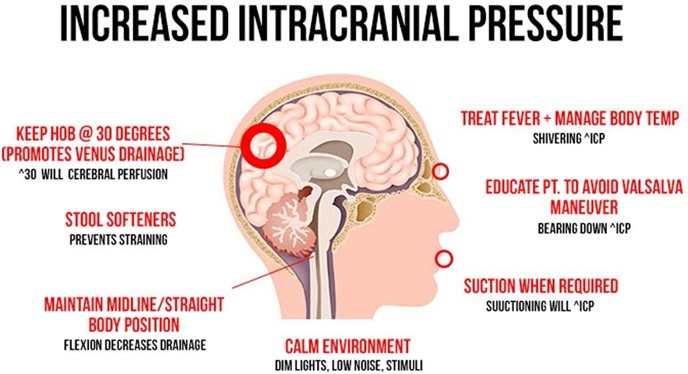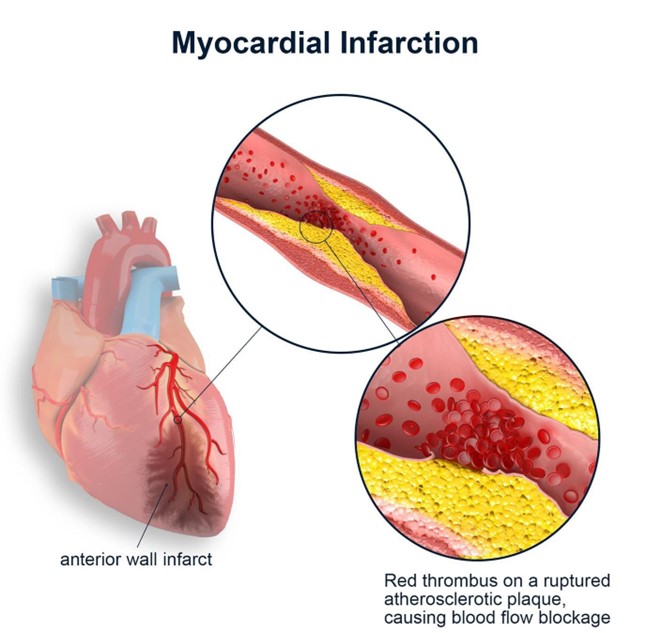A nurse is caring for a client who has increased intracranial pressure (ICP) following a closed-head injury. Which of the following actions should the nurse take?
Use log rolling to reposition the client.
Place a warming blanket on the client.
Instruct the client to cough and deep breathe.
Place the client in a supine position.
The Correct Answer is A
Choice A Reason: This is correct because using log rolling to reposition the client helps maintain the alignment of the head and neck, which prevents further increases in ICP.
Choice B Reason: This is incorrect because placing a warming blanket on the client can cause vasodilation and increase cerebral blood flow, which can raise ICP.
Choice C Reason: This is incorrect because instructing the client to cough and deep breathe can increase intrathoracic pressure and impede venous return, which can elevate ICP.
Choice D Reason: This is incorrect because placing the client in a supine position can decrease cerebral perfusion pressure and increase ICP. The client should be placed in a semi-Fowler's position with the head elevated at 30 degrees.
Nursing Test Bank
Naxlex Comprehensive Predictor Exams
Related Questions
Correct Answer is D
Explanation
Choice A Reason: Observing for cerebrospinal fluid (CSF) leaks from the evacuation site is important, but not the first action that the nurse should take. CSF leaks can indicate a breach in the dura mater, which can increase the risk of infection and meningitis. The nurse should inspect the dressing and the nose and ears for any clear or bloody drainage, and report any findings to the provider. However, these measures are secondary to ensuring adequate oxygenation and perfusion.
Choice B Reason: Checking the oximeter is also important, but not the first action that the nurse should take. The oximeter measures the oxygen saturation of the blood, which reflects the adequacy of gas exchange in the lungs. The nurse should maintain the oxygen saturation above 90%, and administer supplemental oxygen as prescribed.
However, these measures are secondary to ensuring adequate oxygenation and perfusion.
Choice C Reason: Assessing for an increase in temperature is another important action, but not the first one that the nurse should take. An increase in temperature can indicate an infection, inflammation, or damage to the hypothalamus, which can affect the thermoregulation of the body. The nurse should monitor the temperature and administer antipyretics as prescribed. However, these measures are secondary to ensuring adequate oxygenation and perfusion.
Choice D Reason: Monitoring for manifestations of increased intracranial pressure is the first action that the nurse should take. Increased intracranial pressure can result from bleeding, swelling, or fluid accumulation in the brain, which can compress and damage brain tissue and blood vessels. The nurse should assess for signs and symptoms of increased intracranial pressure, such as headache, nausea, vomiting, altered level of consciousness, pupillary changes, or Cushing's triad (bradycardia, hypertension, and irregular respirations). The nurse should also intervene to prevent or reduce increased intracranial pressure, such as elevating the head of the bed, maintaining normothermia, and administering osmotic diuretics. Monitoring for manifestations of increased intracranial pressure is essential to prevent further brain injury and preserve neurological function.

Correct Answer is C
Explanation
Choice A Reason: This choice is incorrect because laboratory testing of serum potassium upon admission is an appropriate prescription for a client who has acute heart failure following MI. Serum potassium is an electrolyte that affects the cardiac function and rhythm. A normal serum potassium range is 3.5 to 5 mEq/L, and an abnormal level can indicate hypokalemia or hyperkalemia, which can cause arrhythmias, muscle weakness, or paralysis. Therefore, monitoring serum potassium is important to detect and correct any electrolyte imbalance and prevent complications.
Choice B Reason: This choice is incorrect because bumetanide 1 mg IV bolus every 12 hr is an appropriate prescription for a client who has acute heart failure following MI. Bumetanide is a loop diuretic that helps to reduce fluid retention and edema by increasing the urine output and sodium excretion. It may be used for clients who have heart failure, hypertension, or renal impairment, but it can cause hypokalemia, hypotension, or dehydration.
Therefore, administering bumetanide as prescribed can help to improve the cardiac output and reduce the preload and afterload.
Choice C Reason: This choice is correct because 0.9% normal saline IV at 50 mL/hr continuous is an inappropriate prescription for a client who has acute heart failure following MI. 0.9% normal saline is an isotonic solution that contains the same concentration of solutes as blood plasma. It may be used for clients who have fluid loss, dehydration, or shock, but it can worsen fluid overload and pulmonary edema in clients who have acute heart failure. Therefore, clarifying this prescription with the provider is necessary to prevent further deterioration of the client's condition.
Choice D Reason: This choice is incorrect because morphine sulfate 2 mg IV bolus every 2 hr PRN pain is an appropriate prescription for a client who has acute heart failure following MI. Morphine sulfate is an opioid analgesic that helps to relieve pain and anxiety by binding to the opioid receptors in the brain and spinal cord. It may be used for clients who have moderate to severe pain, dyspnea, or chest discomfort, but it can cause respiratory depression, hypotension, or nausea. Therefore, administering morphine sulfate as prescribed can help to reduce the oxygen demand and improve the cardiac function.

Whether you are a student looking to ace your exams or a practicing nurse seeking to enhance your expertise , our nursing education contents will empower you with the confidence and competence to make a difference in the lives of patients and become a respected leader in the healthcare field.
Visit Naxlex, invest in your future and unlock endless possibilities with our unparalleled nursing education contents today
Report Wrong Answer on the Current Question
Do you disagree with the answer? If yes, what is your expected answer? Explain.
Kindly be descriptive with the issue you are facing.
